Meta Vaux Warrick Fuller
American, (1877–1968)
Meta Vaux Warrick Fuller was an African American female artist who specialized in sculpture. Born in Philadelphia, Pennsylvania in 1877, her career peaked during America’s Gilded Age, a time when more women were trained as artists than ever before. She attended the Pennsylvania Museum School of Industrial Arts in 1897 (now Pennsylvania College of Art) before traveling abroad to study in Paris, France in 1899. Warrick studied at the Académie Colarossi for sculpture and La Ecole des Beaux Arts for drawing. It was during this time that she met Auguste Rodin, who encouraged her to continue the sculptural realism that she loved. This advice invigorated her art. With her new confidence, she exhibited at Samuel Bing’s L’Art Nouveau Gallery in Paris in 1900.
Meta Warrick returned to Philadelphia in 1902. Eleven years after her return she married Dr. Solomon Fuller of Massachusetts. In 1910 she created signature piece, Ethiopia Awakening which in many ways anticipated the Harlem Renaissance two decades later. As the depiction of an ancient black Egyptian coming back to life, this piece exemplifies a determination to shatter Africa’s association with slavery and ignorance. In the time that Fuller created this piece, only Ethiopia of all the African nations had successfully maintained its independence against European imperialists. Fuller created the piece as a historical validation and celebration of Africans and their connection to African Americans.
In a similar vein, Fuller also completed a commemorative plaque in honor of Emperor Menelik II of Abyssinia (Ethiopia) in 1912. In the 1930s and 1940s, Fuller became increasingly active in church work and as a result her sculpture took on a religious theme that manifested itself in her version of the Pieta in 1930. Fuller retired from her work in the 1950s to care for her ailing husband and to recover from her own bout with tuberculosis. In the 1960s she returned to sculpture, creating tributes to the civil rights movement before dying in 1968 at age 90.
Sources: Renée Ater, “Making History,” American Art (Vol 17 Issue 3, Fall 2003); Sharon E. Patton, African American Art (Oxford University Press: Oxford, 1998).
American, (1877–1968)
Meta Vaux Warrick Fuller was an African American female artist who specialized in sculpture. Born in Philadelphia, Pennsylvania in 1877, her career peaked during America’s Gilded Age, a time when more women were trained as artists than ever before. She attended the Pennsylvania Museum School of Industrial Arts in 1897 (now Pennsylvania College of Art) before traveling abroad to study in Paris, France in 1899. Warrick studied at the Académie Colarossi for sculpture and La Ecole des Beaux Arts for drawing. It was during this time that she met Auguste Rodin, who encouraged her to continue the sculptural realism that she loved. This advice invigorated her art. With her new confidence, she exhibited at Samuel Bing’s L’Art Nouveau Gallery in Paris in 1900.
Meta Warrick returned to Philadelphia in 1902. Eleven years after her return she married Dr. Solomon Fuller of Massachusetts. In 1910 she created signature piece, Ethiopia Awakening which in many ways anticipated the Harlem Renaissance two decades later. As the depiction of an ancient black Egyptian coming back to life, this piece exemplifies a determination to shatter Africa’s association with slavery and ignorance. In the time that Fuller created this piece, only Ethiopia of all the African nations had successfully maintained its independence against European imperialists. Fuller created the piece as a historical validation and celebration of Africans and their connection to African Americans.
In a similar vein, Fuller also completed a commemorative plaque in honor of Emperor Menelik II of Abyssinia (Ethiopia) in 1912. In the 1930s and 1940s, Fuller became increasingly active in church work and as a result her sculpture took on a religious theme that manifested itself in her version of the Pieta in 1930. Fuller retired from her work in the 1950s to care for her ailing husband and to recover from her own bout with tuberculosis. In the 1960s she returned to sculpture, creating tributes to the civil rights movement before dying in 1968 at age 90.
Sources: Renée Ater, “Making History,” American Art (Vol 17 Issue 3, Fall 2003); Sharon E. Patton, African American Art (Oxford University Press: Oxford, 1998).
Artist Objects
Woman and Window 1987.045


